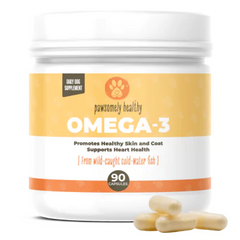
Omega-3 Supplement For Dogs: How To Choose The Best One For Your Pup?
Share
Omega-3 is arguably the single most potent supplement you can add to your dog’s diet.
Out of the six dogs in the Pawsomely Healthy family, five are taking Omega-3 supplements daily. Floridian German Shepherds and avid swimmers Lio and Remy take them for their pawsome, luscious coats; Fox Terrier Ace takes Omega-3s for his multiple allergies; English Bulldog puppy Bruno counts on them to grow smart and strong, and our senior Labrador Cody hopes they can help him stay sharp and limber longer.
After all, amongst wide-ranging positive effects on the canine’s health proven by countless studies,
omega-3 fatty acids can:
- contribute to the brain development of puppies,
- slow down cognitive decline in older dogs,
- strengthen the immune system,
- reduce inflammation,
- increase the ability to fight cancer,
- benefit heart health,
- improve the skin and coat condition,
- help alleviate allergies,
- reduce anxiety, depression, and hyperactivity

Many dog parents have heard about the health benefits of omega-3 fatty acids, and know there are several omegas found in foods and supplements. However, it’s important to know exactly what they are, what role they play in the dog’s body, how they contribute to health, and what foods contain them so we can supplement our pet’s diets more effectively.
In this blog, we will demonstrate that not all omega-3 fatty acids are created equal and we need to make sure we are giving our four-legged companions the right kind, and as maintained by our standards.
While dogs can produce some types of fatty acids out of other nutrients, certain types, like omega-3 fatty acids, must be directly supplied from dietary sources. These fatty acids are called essential fatty acids (EFAs).
Omega‐3 polyunsaturated fatty acids are a family consisting of eleven both short‐ and long‐chain omega-3 fatty acids:
- Docosahexaenoic Acid (DHA)
- Eicosapentaenoic Acid (EPA)
- Alpha-linolenic Acid (ALA)
- Hexadecatrienoic Acid (HTA)
- Stearidonic Acid (SDA)
- Eicosatrienoic Acid (ETE)
- Eicosatetraenoic Acid (ETA)
- Heneicosapentaenoic Acid (HPA)
- Docosapentaenoic Acid (DPA)
- Tetracosapentaenoic Acid
- Tetracosahexaenoic Acid
The shortest chain fatty acid in this family is α‐linolenic acid, ALA. ALA is a precursor for the long‐chain and more unsaturated omega‐3 long‐chain omega-3 fatty acids, such as eicosapentaenoic acid (EPA) and docosahexaenoic acid (DHA).
The majority of scientific research focuses on these three.
DHA and EPA are present in fish, fish oils, and krill oils, but they are originally synthesized by microalgae, not by the fish. When fish eat phytoplankton that ate microalgae, they accumulate the omega-3s in their tissues.
Green-lipped mussel oil is another excellent source of omega-3 fatty acids. Other than EPA and DHA, this shellfish also contains trace amounts of eicosatetraenoic acid (ETA). This rare omega-3 fatty acid may be even more effective at lowering inflammation than other omega-3s.
ALA is present in plant oils, such as flaxseed, soybean, and canola oils.
When it comes to health benefits in dogs, extensive research has shown that the EPA and DHA are most potent. For that reason, it is recommended to supplement the diet of your dog with omega-3 fatty acids high in bioavailable EPA and DHA.
While the metabolism of dogs is able to convert ALA into the longer-chain omega-3 fatty acids, the rate of conversion (which occurs primarily in the liver) is very low, with only 5% to 15% ALA converting to EPA and less than 1% of ALA converting to DHA. Therefore, consuming EPA and DHA directly from foods and/or dietary supplements is the only practical way to increase levels of these fatty acids in the body.
And therein lies the controversy.
The commercial foods for dogs available on the market today vary greatly in their EPA and DHA content, with some dog food with Omega 3 having almost negligible or very low amounts of these fatty acids.
Besides, since labeling legislations do not clearly distinguish between the two groups of omega‐3 polyunsaturated fatty acids, that is short‐chain (ALA) versus long‐chain (EPA and DHA), some dog food labels claim to be rich in omega‐3, even though they contain only short‐chain polyunsaturated fatty acids that solely act as a source of energy and are not directly linked to health benefits.
For example, many commercial dog foods are supplemented with vegetable oils such as flaxseed oil, canola oil, walnut oil and soybean oil that can only provide dogs with the short‐chain omega‐3 fatty acid, ALA.

According to the latest study recently published in Veterinary Medicine and Science, “Enhanced omega‐3 index after long‐versus short‐chain omega‐3 fatty acid supplementation in dogs”, (Tonje E. Domingues, Kirapreet Kaur, Lena Burri, October 2020), many pet parents are led astray by marketers of pet food and standalone supplements by leading them to believe they are getting the right kind of omega-3s that can provide powerful health benefits for their dog or cat, while in fact, they are not.
The aim of the study was to compare the effect of supplementation with a plant‐based short‐chain polyunsaturated fatty acids’ source (flaxseed oil) with a marine long‐chain polyunsaturated fatty acids’ source (astaxanthin krill oil) to increase the Omega‐3 Index (a test that measures the amount of EPA and DHA in red blood cell membranes, which is expressed as a percentage of all fatty acids) in dogs.
Ten adult Alaskan Huskies of both genders were supplemented daily with 1,155 mg of EPA/DHA from krill oil, whereas another 10 dogs received 1,068 mg ALA from flaxseed oil for 6 weeks. Fatty acid and Omega‐3 Index measurements of the two groups were taken after 0, 3 and 6 weeks for comparison.
The results of the study were alarming.

The EPA and DHA concentrations increased significantly only in the dogs fed with krill oil resulting in a significant increase in mean Omega‐3 Index, from 1.68% at baseline to 2.7% after 6 weeks of supplementation.
On the contrary, both EPA and DHA concentrations decreased significantly in the dogs fed with flaxseed oil, which led to a significant decrease in mean Omega‐3 Index from 1.6% at baseline to 0.96% at study end.
This suggests that pre-formed marine EPA and DHA sources are needed in dog foods, as the dietary requirements proposed by feed industry organizations are not met with the conversion from plant‐based sources of omega-3 fatty acids.
So, with so many omegas available on the market, confusing labeling laws, misleading marketing claims, how do I choose the right omega-3 supplement for my dog, you ask? The following are some
important things to consider:
1. Most pet food labels claim that their feeds are formulated to contain adequate levels of all vitamins and nutrients required by your dog. Omega-3 fatty acids are temperature sensitive. The vast majority of commercially processed pet foods available on the market, especially kibble, are manufactured at very high temperatures, which is detrimental to omega-3 fatty acids.
Even if you feed your dog a raw diet, there is a high chance that you are missing out on omega-3 fatty acids if you are not consciously adding seafood or marine oils to your pet’s diet.
2. Best Omega-3 for dogs are rich in eicosapentaenoic acid (EPA) and docosahexaenoic acid (DHA).
Plant oils like flaxseed or canola oil are high in omega-3 fatty acids. However, the omega-3 in these oils is high in alpha-linolenic acid (ALA) and does not contain EPA and DHA. This prevents plant oils from providing the desired health benefits to your dog.
Omega-3 fatty acids high in EPA and DHA and low in ALA are found in fish and other marine sources.

3. Healthy sources of Omega-3 fatty acids rich in EPA and DHA are small fatty ocean fish with short lifespan like sardines or anchovies that feed from krill (small, shrimp-like crustaceans) as well as fish oils made from these small fish, krill oil, or phytoplankton.
Large carnivorous fish (tuna, mackerel, and seabass) tend to accumulate toxins, including heavy metals like arsenic, cadmium, lead, and mercury over their longer lifespan. This is why feeding these types of fish to our pets is not recommended.
4. Fish oil capsules are preferable over bottles or pump dispensers. The latter tend to oxidize fast and can easily get rancid. It can be challenging, however, to supplement EPA and DHA in the form of fish oil capsules to large dogs because EPA and DHA concentrations in standard fish oil capsules are not high.
So, if you happen to have a large dog, look for supplements like Omega-3 by Pawsomely Healthy, that come in the form of a powder, which allows to achieve a longer shelf life and higher concentration of EPA and DHA.
5. Omega-3 supplement for dogs should be free of toxins, pollutants, additives, colors, fillers, preservatives and, ideally, sustainably harvested.
6. Only buy omega-3 supplements from certified suppliers (not unknown sources on the internet).

Omega-3 by Pawsomely Healthy contains fish oil from wild-caught cold-water fish of the South Pacific (anchovies) that is is spray-dried and capsulized to retain purity, freshness, and deliver the most authentic and nutritionally effective form of fish oil.
Unlike many omega-3 supplements, our Omega-3 has a high concentration of omega-3 fatty acids EPA and DHA, an essential "good" type of fat that helps your dog’s body and brain. It comes in the form of mess-free powder-filled vegetable capsules that we recommend giving to your dog during feeding times. Just put the capsule in a bowl with food. If your dog doesn’t eat the whole capsule, you can open it and sprinkle the powder on your dog’s food.
Learn more about our Omega-3 --->
